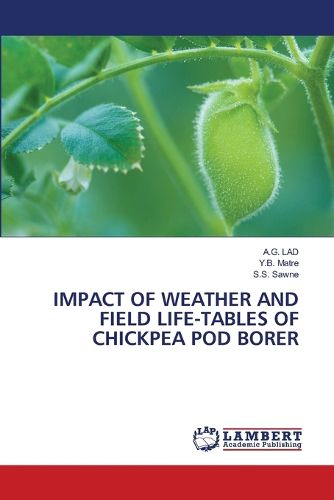Readings Newsletter
Become a Readings Member to make your shopping experience even easier.
Sign in or sign up for free!
You’re not far away from qualifying for FREE standard shipping within Australia
You’ve qualified for FREE standard shipping within Australia
The cart is loading…






The incidence of H. armigera in second generation was noticed in second week of February (7th SMW). The data revealed that 19.45 % eggs did not hatch into the larvae due to the reason of sterility (Table No.6). In Early instar larvae to the extent of 0.51% were died by unknown reasons, 0.40 % due to NPV and 5.50 % due to C. chlorideae. The mortality of late instar larvae to the extent of 3.42 and 9.60% was observed due to Apanteles spp. and G. halli, respectively. The pupal mortality was observed due to G. halli (6.57%). The zero trend index revealed that the population of H. armigera infesting chickpea was ceased after second generation. The generation survival was recorded 0.76.It is evident from Table No.7 that maximum mortality of H. armigera was observed in the eggs stage (K= 0.0939) followed by late instar larvae (K = 0.0579) and pupal stage (K= 0.0305) and early instar larvae (K=0.0286). The total 'K' for all the life-stages was 0.5119. It indicates from the observations on H. armigera infesting chickpea during Rabi 2020-21 that egg sterility and G. halli, NPV and C. chlorideae were found to be key mortality factors of H. armigera.
$9.00 standard shipping within Australia
FREE standard shipping within Australia for orders over $100.00
Express & International shipping calculated at checkout
The incidence of H. armigera in second generation was noticed in second week of February (7th SMW). The data revealed that 19.45 % eggs did not hatch into the larvae due to the reason of sterility (Table No.6). In Early instar larvae to the extent of 0.51% were died by unknown reasons, 0.40 % due to NPV and 5.50 % due to C. chlorideae. The mortality of late instar larvae to the extent of 3.42 and 9.60% was observed due to Apanteles spp. and G. halli, respectively. The pupal mortality was observed due to G. halli (6.57%). The zero trend index revealed that the population of H. armigera infesting chickpea was ceased after second generation. The generation survival was recorded 0.76.It is evident from Table No.7 that maximum mortality of H. armigera was observed in the eggs stage (K= 0.0939) followed by late instar larvae (K = 0.0579) and pupal stage (K= 0.0305) and early instar larvae (K=0.0286). The total 'K' for all the life-stages was 0.5119. It indicates from the observations on H. armigera infesting chickpea during Rabi 2020-21 that egg sterility and G. halli, NPV and C. chlorideae were found to be key mortality factors of H. armigera.